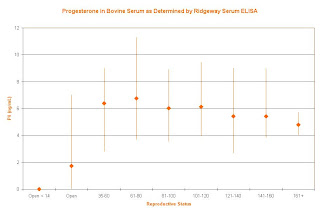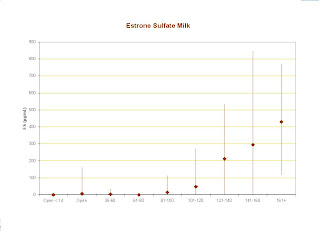I am now in my final week of my internship. What have I learned? Twelve weeks is a very short time to complete a research project. I have also deepened my understanding of diagnostic immunology, lab techniques, and research and development in private industry.
The above charts show the final progesterone values obtained from our sample bank. Based on the results obtained from approximately 160 cows in various stages of pregnancy, we have determined that cows with progesterone levels in serum less than or equal to 2 ng/mL should be considered open. Cows with progesterone levels in milk less than or equal to 5 ng/mL should be considered open. AntelBio will soon be offering progesterone testing on DHIA milk samples. The research crew at AntelBio will continue working on creating an in-house progesterone assay. By developing one's own assay, AntelBio will be able to provide this service at a significantly reduced cost to producers.
The estrone sulfate assay data for the same cows has been turned over temporarily to the parent company to determine if the variability in results is due to the assay, improper technique in the Antel lab, or my amateur ELISA skills. The research to develop a more sensitive assay for estrone sulfate will continue. If this assay can be refined and improved it will also be offered in the future for DHIA milk samples. This would provide a great management tool for producers.
Finally, I would like to thank Todd and Bridgette for their wealth of knowledge and guidance. I wouldlike to thamk all of the AntelBio employees for their support and being such fun people to work with.















